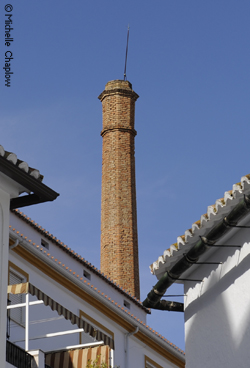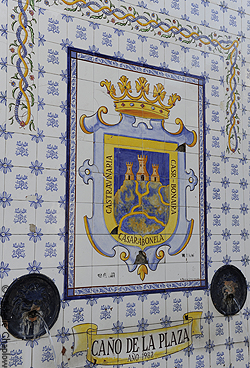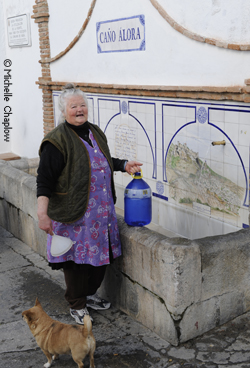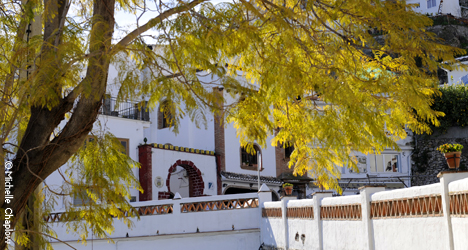What to See in Casarabonela

19th century industrial chimney
From this village, one can see the comings and goings all the way down to the coast. Yet driving up from Málaga, the village hides behind various hills and it is not until a few kilometres away that eventually a large white pueblo comes into view. Like many of the white villages, it is the site of the castle that dominates the community. Follow the signs for El Burgo and the road follows the village from below. Passing a small shrine that asks for donations to admire the view, the road dips over a small stream. Here the old pack horse bridge can be seen with the original track leading up to the town, which in Moorish days was walled.
This pueblo has seen a lot of development in recent years, with many low-rise apartments being built to the left of the old centre. The road winds its way through this area, passing a mock Moorish arched gateway into the old town. Keep driving up until you leave the main road and enter the town from the top. Park as soon as you can, though the height you have gained is on your side. To find the heart of the old village, keep walking towards the church, passing an old 19th century industrial chimney, with its crocked top. Even though you will notice that many of the buildings are new, the town has maintained its vernacular layout and appearance. On entering the Plaza, the church on solid foundations dominates the square. Traffic still insists on entering the cramped upper part of town but before discovering the town, the largely ruined castle and church are worth a visit.
The large Parish Church of St James was at the highest part of the village just below the castle. Built on the foundations of the former mosque, it was an old collegiate church, fashioned in the late Gothic style of the 16th century. Very little of the original church remains since it has been heavily restored over the years. The tower is the highest feature in the village, capped with a pyramid shaped roof, of ceramic tiles. Looking at the tower's base, it can be concluded that this is Moorish. The facade is marked by the cross of St James.

Ornate fountain in the Plaza de Casarbonela
If you can get inside (as the door is often locked, due to the location of a small silver museum), you will discover three naves separated by arches supported by rectangle pillars. The 18th century altar screen is typically heavy, with a painted wooden image of Our Lady of the Rosary, made by Rafael Ruiz Liebana. The side chapels are pleasant, containing their own stalls. Walking around the church from the outside, you will realise that it sits on a large piece of land. Not only does it contain the church, it has a garden which probably originates from the time this site was a mosque. The old collegiate buildings and priest houses complete the complex, with a parish room at the back.
From the church the Castle ruins can be seen, which make an interesting mirador (lookout) point. Built on a rocky outcrop, there is not much to see of the walls but the view is well worth the walk. The entrance to the site is behind a door resembling someone's home. Opening hours are restricted, closing for lunch at 1PM.
Once in the grounds of the old castle, interpretative signs are of interest. The castle had a curtain wall that surrounded the whole plateau. The keep was small and it is presumed that the keep contained many wooden barrack and administrative buildings. The old entrance is maintained and was the site of the stables. A natural cave was incorporated into this feature.
In the heart of the village past the plaza, a second smaller open space is found dominated by a pleasant Town Hall with its clock. The whole town meets here every New Years Eve to eat their 12 grapes from the chimes of the clock. How long ago when this last happened is not known as the clock is in need of some serious maintenance. Again a good view can be seen of the town and valley from this point.

Collecting water from the village fountain
Dropping down even further, the Ermita de la Veracruz can be found. This passes the town's fountain, which contains an interesting mural, reconstructing what the town must have looked like in the Moorish era. Other than the castle and main mosque, the town was surrounded by defensive walls and contained a number of smaller shrines. The large 18th century chapel is dedicated to the true cross and has a long simple nave, with a facade bell tower. A large central tower can be seen before the high alter containing the statue of the Virgin de los Rondales. When built, the church must have crossed over a right of way, which is still open via a tunnel to the edge of the town. The church has recently been restored and it was intended that this was to become a museum. However, it does have opening times though you need to be quick. It opens from 19:00 - 19:30 on Saturday and for 1 hour on Sunday.
A later 19th century hermitage church can be seen at Ermita del Calvario.

Antigua Venta de San Antonio
Located on the minor but now major route that linked Ardales to Malaga, this old inn fell into despair in the 1960s, when the traffic shifted to better roads. Now that the modern highway has revitalised the corridor, a two-year restoration project has been completed.
The venta (inn) is thought to date from the 17th century and was enlarged in the following 100 years. It acted not only as a watering hole, but offered travellers overnight accommodation and the chance to rest their horses. The complex also acted as a cortijo and barns were used to store locally produced maize. The inn was an important link during the 19th century, when the spa at Carratraca was popular and well-known throughout fashionable Europe. It is said that personalities such as Cervantes and Eugenia de Montijo, who married Napoleon III, used the inn on their way back from the spa to Malaga. Today the barn complex has been converted into a restaurant that seats 250. The old store rooms have survived, and the patio and horses trough preserved. There are also plans to convert some of the old animal pens into a rural hotel.